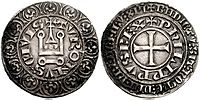Philip V of France facts for kids
Quick facts for kids Philip V |
|
|---|---|
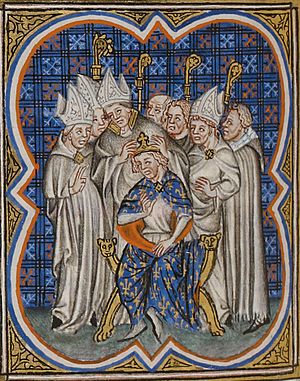
Contemporary miniature depicting the coronation of Philip V.
|
|
| King of France and Navarre (more...) | |
| Reign | 20 November 1316 – 3 January 1322 |
| Coronation | 9 January 1317 |
| Predecessor | John I |
| Successor | Charles IV and I |
| Born | c. 1293 Lyon, France |
| Died | 3 January 1322 (aged 29) Abbey of Longchamp, Bois de Boulogne, Paris, France |
| Burial | 8 January 1322 Saint Denis Basilica |
| Spouse | |
| Issue | Joan III of Burgundy Margaret I of Burgundy Isabelle of France Blanche of France |
| House | Capet |
| Father | Philip IV of France |
| Mother | Joan I of Navarre |
Philip V (born around 1293 – died January 3, 1322), also known as Philip the Tall (Philippe le Long), was the King of France and Navarre (as Philip II). He ruled from 1316 to 1322.
Philip was the second son of Philip IV of France. He became the Count of Poitiers. His older brother, Louis X, became king in 1314. When Louis X died in 1316, he left a daughter and a pregnant wife. Philip successfully became the regent, meaning he ruled until a new king could be chosen. Louis X's wife, Clementia, gave birth to a boy, John I, who was king for only five days before he died.
After his nephew's death, Philip quickly had himself crowned king. However, some people thought Louis X's daughter, Joan, should be queen. Philip argued against her claim. He pointed out her young age and some questions about her background. Also, a group of important people, the Estates General, decided that women should not inherit the French throne. Philip becoming king instead of Joan set a new rule for French succession, which later became known as the Salic law.
Philip V improved relations with the County of Flanders, which had been fighting France. But his relationship with Edward II of England became difficult. Edward, who was also the Duke of Guyenne, at first refused to show loyalty to Philip. In 1320, a group of common people started a popular movement in Normandy. They wanted to fight in the Iberian Peninsula. Instead, they attacked castles, royal officials, and some groups of people like lepers and Jews.
Philip V made many changes to improve how the kingdom was run. He created a special court for finances. He also worked to make weights and measures the same across the country. He tried to create a single currency for France.
Philip V died from a sickness called dysentery in 1322. He did not have any sons. His younger brother, Charles IV, became the next king.
Contents
Who Was Philip V?
Philip was born in Lyon, France, around 1293. He was the second son of King Philip IV of France and Queen Joan I of Navarre. His father made him the Count of Poitiers. Historians describe Philip V as a very smart and thoughtful person. They say he was the "wisest" of Philip IV's three sons.
Philip learned from the problems his father faced in 1314. He also saw the difficulties his older brother, Louis X, had during his short reign. A big problem for both kings was collecting taxes, especially when there wasn't a crisis.
Philip married Joan of Burgundy in 1307. She was the daughter of Otto IV, Count of Burgundy. They had many children quickly. Philip was very generous to Joan. He gave her lands, money, jewels, and even the property of all the Jews in Burgundy in 1318. He wanted to make sure these gifts would stay hers even if he died early.
Becoming King and the Salic Law
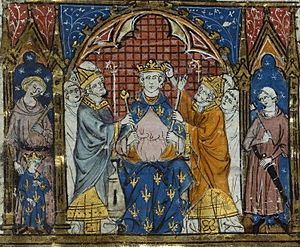
Philip's older brother, Louis X, died in 1316. His wife, Clementia, was pregnant. Many people wanted to be regent, including Charles of Valois. But Philip was smarter and became the regent. He ruled while Clementia was pregnant and for a few days after her son, John I, was born. Baby John lived for only five days.
After John I died, France faced a new problem. For the first time, a French king died without a son. The next king was not clear. Joan, Louis X's daughter, was one choice. But people still had doubts about her because of a scandal in 1314.
Philip quickly made deals with powerful nobles. He convinced Charles of Valois to support him instead of Joan. Philip also arranged for his daughter to marry Odo IV. In return, Odo stopped supporting Joan's claim to the French throne. On January 9, 1317, Philip was crowned king in Reims. Many nobles did not attend the ceremony.
Philip called a meeting of nobles in Paris on February 2. He stated that Joan, as a woman, could not inherit the French throne. He also reminded everyone that he was now the crowned king. This decision, which stopped women from becoming queen of France, became known as the Salic law. However, Joan did become Queen of Navarre in 1328, because Navarre did not follow the Salic law.
The next year, Philip made his position even stronger. He married his oldest daughter, Joan, to the powerful Odo IV. Philip then focused on making reforms. He wanted to get back rights, money, and lands that had been lost to the crown.
Changes and Improvements in France
Philip was seen as a "strong and popular" king. This was impressive because he inherited a difficult situation with bad harvests. He followed his father, Philip IV, in trying to make France's money system strong. He also undid many unpopular decisions made by his older brother, Louis X.
Philip also made changes to the government. He improved the currency and worked to make weights and measures the same across the country. One important person Philip appointed was Pierre Bertrand, who later became a cardinal.
In 1317, Philip reissued a law from his father's time. This law condemned the theft of royal resources and offices in the provinces. By 1318, Philip went further. He made a clear difference between the royal domain (lands and titles that always belonged to the crown) and lands that had been taken back by the crown as punishment. Philip said that new lands given to nobles would usually come from these forfeited lands. This helped strengthen the crown's power. Philip also created the cours des comptes in 1320. This court checked the royal accounts to make sure money was handled correctly. These courts still exist today.
Dealing with Flanders and England
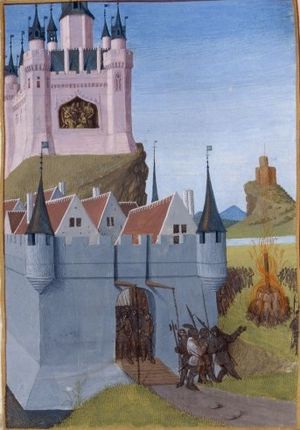
Philip successfully solved the ongoing problem with Flanders. Flanders was a very rich area that was mostly independent from France. The French king was supposed to be the ruler of Flanders, but their relationship was tense. Philip's father, Philip IV, had lost a battle there in 1302. Even after a French victory later, the situation remained difficult.
Robert III of Flanders kept fighting France. But by the time Philip became king, Robert was losing support in Flanders. France also struggled to pay for the war. Louis X had stopped sending grain to Flanders in 1315, which led to smuggling. Philip started to pay back people for supplies in 1317, but things were still unstable.
Both Philip and Robert decided to find a peaceful solution. In June 1320, Robert agreed that his grandson, Louis, would be his heir. In return, Louis would marry Philip's second daughter, Margaret. This gave Robert and Louis strong French support in Flanders. Louis had grown up in France and was very loyal to Philip. This was a big success for Philip. However, Louis's strong French loyalties later caused problems and a peasant revolt in Flanders.
Philip also had problems with Edward II of England. Edward, as the ruler of Gascony, owed loyalty to the French king. But as a king himself, he did not want to do this. Edward had not shown loyalty to Louis X. At first, he refused to do so for Philip. In 1319, Philip allowed Edward to send someone else to show loyalty. But in 1320, Philip expected Edward to come in person. Edward arrived in Amiens, but Philip then insisted Edward also swear a personal oath of loyalty. Edward showed loyalty but refused the oath. This showed that France was putting more pressure on England over Gascony.
Crusades and Popular Movements
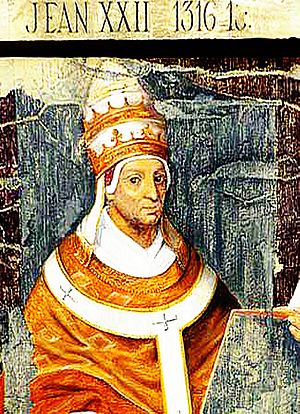
Philip was also involved in the idea of crusades. Pope John XXII, who was elected in 1316 with Philip's help, wanted new crusades. Philip IV had agreed to a plan for a French-led crusade in 1312, and Philip V himself had promised to join in 1313. Once he was king, Philip had to follow through. He asked Pope John for money for crusades. Both Philip and John agreed that a French crusade was not possible while Flanders was unstable.
An attempt to send a naval force from southern France failed in 1319. Philip then held meetings with military leaders to plan another expedition. However, by the end of Philip's reign, he and the Pope disagreed about money for crusades. Their attention turned to dealing with the Shepherds' Crusade.
The Shepherds' Crusade started in Normandy in 1320. Some historians believe that repeated calls for crusades, without any big expeditions actually happening, led to this uncontrolled movement. Philip's plans for a new crusade were well known. Also, peace in Flanders meant many peasants and soldiers were without work. This led to a large and violent movement that threatened local Jews, royal castles, and wealthy clergy. The movement was condemned by Pope John. Philip had to use his army to stop it. The remaining groups were driven south into Aragon.
Philip's Final Year
The "Leper Scare"
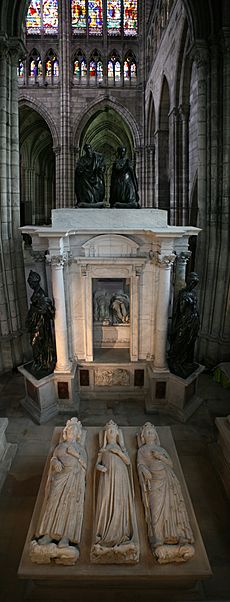
In 1321, a strange fear spread across France, known as the "leper scare." People wrongly believed that lepers were poisoning town wells. This fear grew because of the Shepherds' Crusade the year before and a decade of bad harvests.
At this time, Philip had ordered his officials to help Jewish money lenders get back debts from Christians. This made some people dislike the Jewish community even more. Rumors about lepers had also spread in 1320.
Philip was in Poitiers in June when he heard about the scare. He quickly ordered that any leper found guilty should be burned, and their belongings taken by the crown. Philip's plans to reform the south had already caused local opposition. This put Philip in a difficult spot. He couldn't openly support the false accusations without causing more violence. But if he didn't act, people might take matters into their own hands, weakening his power. Some Jewish people left France because of this fear. However, Philip avoided signing a formal law, which helped limit the damage.
Death and Succession
In August, Philip was still working on his reform plans when he became very ill. After a short time, he died at Longchamp, near Paris. He was buried in Saint Denis Basilica.
Because Philip had established the rule that only sons could inherit the throne, his younger brother, Charles IV, became king. Philip had no sons. Charles also died without a male heir. This eventually led to Edward III of England claiming the French throne and starting the Hundred Years' War (1337–1453).
Philip V's Family
In January 1307, Philip V married Joan II, Countess of Burgundy. She was the daughter of Otto IV, Count of Burgundy. They had five children:
- Joan (born 1308 – died 1349), who became Countess of Burgundy and Artois. She married Odo IV, Duke of Burgundy.
- Margaret (born 1309 – died 1382), who married Louis I of Flanders. She also became Countess of Burgundy and Artois.
- Isabelle (born 1310 – died 1348), who married Guigues VIII de La Tour du Pin, Dauphin de Viennois.
- Blanche (born 1313 – died 1358), who became a nun.
- Philip (born 1316 – died 1317).
Philip V in Stories
Philip is a character in Les Rois maudits (The Accursed Kings). This is a series of French historical novels by Maurice Druon. In the books, Philip is shown as the smartest of Philip IV's three sons. He was played by Josep Maria Flotats in the 1972 TV show and by Éric Ruf in the 2005 TV show.
See also
 In Spanish: Felipe V de Francia para niños
In Spanish: Felipe V de Francia para niños




